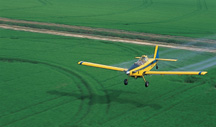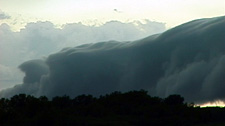 Last week I planned a flight from San Carlos to a crop duster airstrip in the southern end of the San Joaquin Valley.  The weather forecast seemed pretty consistent on my route with occasional rain showers and cloud bases ranging from 3000 to 5000 feet thanks to an active area of low pressure.  I departed IFR to get out of the area, but by the time I got over to the San Joaquin Valley the weather was decent VFR and I cancelled my instrument flight plan and was proceeding comfortably below the clouds at 3500 feet.             Â
Last week I planned a flight from San Carlos to a crop duster airstrip in the southern end of the San Joaquin Valley.  The weather forecast seemed pretty consistent on my route with occasional rain showers and cloud bases ranging from 3000 to 5000 feet thanks to an active area of low pressure.  I departed IFR to get out of the area, but by the time I got over to the San Joaquin Valley the weather was decent VFR and I cancelled my instrument flight plan and was proceeding comfortably below the clouds at 3500 feet.             Â
 About 50 miles from my destination, I noticed what could only be described as wall of clouds blocking my route that seemed to extend up from the ground to the bases of the clouds above me.  I could not circum navigate around it and because there was no instrument approach at my intended destination there was little point in trying to get an instrument clearance.  I opted to call it day and headed back to the barn.
About 50 miles from my destination, I noticed what could only be described as wall of clouds blocking my route that seemed to extend up from the ground to the bases of the clouds above me.  I could not circum navigate around it and because there was no instrument approach at my intended destination there was little point in trying to get an instrument clearance.  I opted to call it day and headed back to the barn.
The next day I learned that a Cessna 210 had been in the same area about an hour before me and had broken up in flight.  The three on board were killed.  The preliminary information indicates that the pilot was not instrument rated and likely lost control of the plane during an inadvertent encounter with IFR conditions.  I could identify with the pilot’s predicament, but not with the tragic outcome.
There are thousands of NTSB fatal aircraft accident reports which contain the familiar words “pilot failed to maintain VFR” as part of the probable cause findings.  A catch-all phrase to be sure, but one that often reflects the prologue of non-instrument pilots who encounter IMC conditions.  Keep in mind that we are talking about situations where the IMC encounter occurs at sufficient altitude with no obstructions nearby and the pilot loses control of an otherwise airworthy aircraft.  Low-level scud running, on the other hand will shorten the life expectancy of both instrument and non-instrument rated pilots alike as they fly, often under complete control, into unforgiving terra firma.
As part of our certification all pilots are required to maintain control of an aircraft by reference to the instruments.  Unfortunately, it is a skill seldom kept proficient by most non-instrumented rated pilots.  In reality it is essential to be able to control an aircraft by instrument reference not only for inadvertent cloud encounters, but also for flying under conditions of night or low visibility when there may be no outside horizon to reference.  The ability to integrate the use of both instrument and outside visual flight references makes one a much more precise, smoother, and safer pilot.
 If you ever find yourself in a position of inadvertently losing outside visual reference your initial objective is to focus on the instruments to maintain a straight and level flight attitude (obstacle clearance permitting) and ignore any false sense of motion that could lead to spatial disorientation.  The attitude indicator will be your best friend here.  You will also have to fight the feelings of anxiety and fear that come with this situation especially if there is turbulence.  Just because you are in the clag, the laws of aerodynamics have not been repealed and your plane will fly just the same.  You will just have to work a little harder and keep your cool.
If you ever find yourself in a position of inadvertently losing outside visual reference your initial objective is to focus on the instruments to maintain a straight and level flight attitude (obstacle clearance permitting) and ignore any false sense of motion that could lead to spatial disorientation.  The attitude indicator will be your best friend here.  You will also have to fight the feelings of anxiety and fear that come with this situation especially if there is turbulence.  Just because you are in the clag, the laws of aerodynamics have not been repealed and your plane will fly just the same.  You will just have to work a little harder and keep your cool.
Use trim to stabilize pitch attitude and apply small, gentle control inputs while keeping your eyes on the instrument panel to maintain straight and level.  A properly trimmed aircraft will fly itself.  Better yet, use the autopilot if you have one.  Just make sure that you thoroughly understand how to use it.  Get help from ATC if you can, but don’t lose control of the plane while fiddling with the radios.  When you get settled you will need to either do a gentle 180-degree turn back to clear skies or climb or descend if cloud bases or tops permit.
Why is it so important to focus on straight and level flight?  A loss of control under IMC typically occurs when the pilot isn’t paying attention or starts succumbing to spatial disorientation and the aircraft starts to bank.  As the wing drops down the aircraft also starts to descend picking up speed.  A pilot will react by pulling back on the yoke without first leveling the wings.  This aggravates the situation by increasing the bank angle, descent rate, air speed and wing loading.  This is often referred to as the “graveyard spiral.”  Speeds can quickly exceed structural limits causing the aircraft to break up as the pilot tries to pull out of it.  If you find yourself in this situation level the wings, reduce power, and slow the aircraft as best you can before gently pulling out of the dive.  Keep it straight and the plane won’t break.
 Ideally the best course of action is not to be in a position where you have to “cancel VFR,” but stuff happens and it is best to be prepared as you would for any potential emergency through recurrent training.  With an instructor on board, a cloud encounter can easily be simulated in VFR conditions by putting on the hood and practicing an exit strategy by doing turns, climbs, and descents with and without the use of an autopilot.  The session should also include unusual attitude recoveries and how to obtain assistance from ATC.  This is simple stuff at which all pilots should be proficient.  Remember that a plane doesn’t care if it is in clear air or clouds; it flies pretty much the same.  As in most things in life, attitude is what counts.
Ideally the best course of action is not to be in a position where you have to “cancel VFR,” but stuff happens and it is best to be prepared as you would for any potential emergency through recurrent training.  With an instructor on board, a cloud encounter can easily be simulated in VFR conditions by putting on the hood and practicing an exit strategy by doing turns, climbs, and descents with and without the use of an autopilot.  The session should also include unusual attitude recoveries and how to obtain assistance from ATC.  This is simple stuff at which all pilots should be proficient.  Remember that a plane doesn’t care if it is in clear air or clouds; it flies pretty much the same.  As in most things in life, attitude is what counts.
Editor’s Note: This article was written by Ken Steiner prior to his retirement from the United States Aircraft Insurance Group as a Vice-President and Claims Manager. During his career, Ken investigated thousands of aircraft accidents involving small planes, crop dusters, helicopters, corporate aircraft, and airliners. He has been on-site at over 100 fatal aircraft accident investigations. He is currently an Aviation Investigative Consultant and is also a Pilot and Tactical Flight Officer for the San Mateo County Sheriff’s Air Support Unit. He owns a Cessna 182 based at San Carlos and holds ATP and CFI certificates with over 5000 flying hours.


